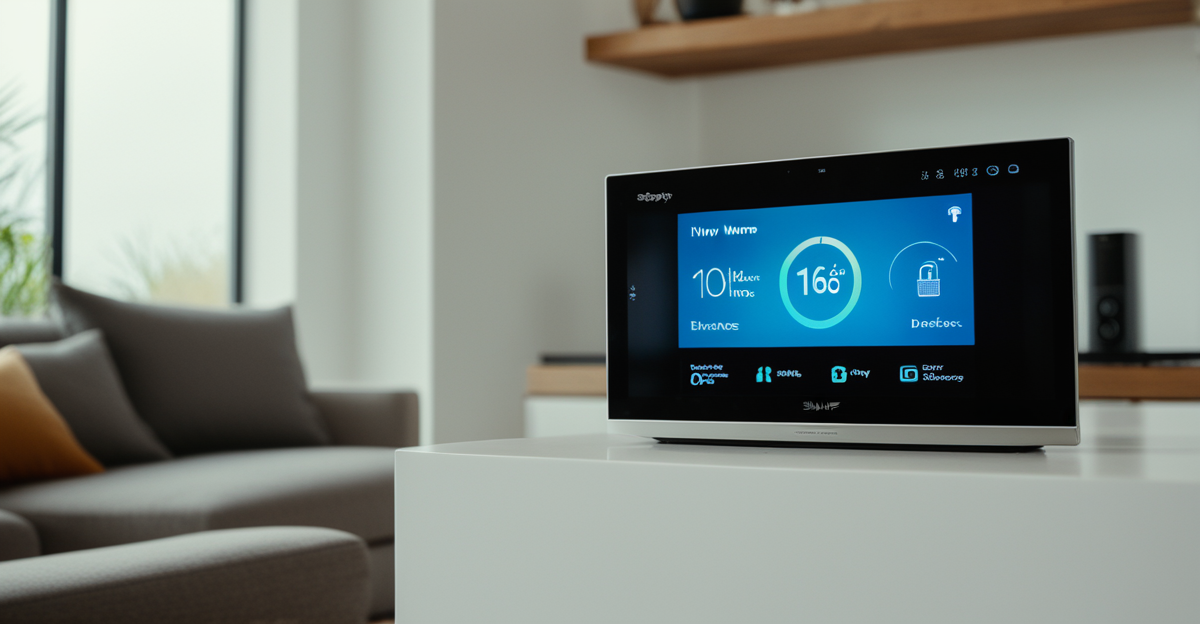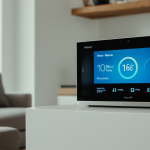Practical Benefits of Smart Home Gadgets
Smart home gadgets provide significant smart home benefits by enhancing everyday convenience and automating routine tasks. One of the key smart device advantages is their ability to save time and energy, streamlining activities like lighting control, climate adjustments, and security monitoring. For instance, you can schedule lights to turn on at dusk or program thermostats to optimize heating and cooling without manual input, reducing both effort and utility costs.
These devices also improve accessibility, catering to users of all ages and abilities. Voice-controlled smart speakers allow hands-free interaction, making it easier for the elderly or individuals with mobility challenges to control their environment. This level of automation reduces physical strain and supports independent living.
Also read : What are the top UK home design trends for 2024?
In addition to convenience, smart home gadgets promote efficiency by simplifying complex systems into manageable routines. By integrating multiple devices, users enjoy seamless control and real-time responses, which translates into more relaxed, productive households. Embracing these advantages helps unlock the full potential of smart homes, making everyday life smoother and more enjoyable.
Practical Benefits of Smart Home Gadgets
Smart home gadgets offer significant convenience and efficiency improvements by automating everyday tasks. These devices enhance routines by allowing users to control lighting, climate, and security remotely or through voice commands. Such smart device advantages save time by reducing manual interventions, letting homeowners focus on what matters most. For example, setting schedules for lighting or thermostats can optimize energy use seamlessly, contributing to time-saving and cost reductions.
Additional reading : How Can You Transform Your Living Space to Reflect Your Personal Style?
Beyond convenience, smart gadgets increase accessibility. People of varying ages and abilities can benefit from voice-activated assistants or automated controls, making home management simpler and more inclusive. This helps in reducing physical strain or cognitive load, especially for older adults or those with disabilities.
Automation also extends to safety features, adding another layer of security without requiring constant attention. The practical benefits of smart home gadgets thus combine enhanced home convenience, efficiency, and accessibility, making daily life smoother for diverse users by streamlining multiple functions into unified, manageable systems.
Practical Benefits of Smart Home Gadgets
Smart home gadgets offer remarkable smart home benefits by significantly enhancing convenience in daily life. Their automation capabilities enable seamless control over lighting, climate, and security, turning complex routines into effortless tasks. This level of convenience reduces the mental load of managing household functions, allowing users more time to focus on what matters.
Time-saving is a primary smart device advantage. For example, automatic scheduling allows lights to adjust based on time of day or occupancy, while smart thermostats optimize temperature efficiently. These features not only save precious moments but also reduce energy consumption, leading to cost savings and environmental benefits.
Accessibility is another critical benefit. Smart devices cater to all ages and abilities by providing voice-controlled interfaces and easy-to-use apps. This inclusivity helps elderly or disabled users maintain independence and comfortably manage their home environment without physical strain.
Together, these smart home benefits create a more efficient, accessible, and time-saving living space. Embracing this technology transforms ordinary homes into adaptive environments tailored to individual needs and lifestyles.
Practical Benefits of Smart Home Gadgets
Smart home benefits center around enhanced convenience and automation, transforming how daily tasks are managed. These gadgets offer practical smart device advantages by automating lighting, climate control, and security systems, allowing seamless operation with minimal user effort. For example, smart thermostats adjust heating automatically based on your schedule, conserving energy while maintaining comfort. Such features contribute directly to time-saving by reducing manual adjustments and enabling smarter use of household energy.
Another important benefit is improved accessibility, ensuring these technologies support users of all ages and abilities. Voice commands and automated controls simplify interactions, helping elderly individuals or those with limited mobility manage their homes independently. Beyond physical ease, this accessibility fosters confidence and convenience, reducing reliance on constant assistance.
Energy efficiency also ties into these benefits by pairing convenience with sustainability. Automated routines optimize resource use quietly in the background, making smart home gadgets essential contributors to more efficient living. The collective impact clearly demonstrates how smart home benefits extend beyond mere luxury to practical solutions suited for diverse lifestyles.
Practical Benefits of Smart Home Gadgets
Smart home gadgets significantly boost convenience by automating everyday tasks such as lighting, climate control, and security. This automation allows users to manage their homes effortlessly, reducing daily hassles. For example, lights can adjust automatically based on occupancy or time, creating an adaptive and comfortable environment without manual input.
A core smart device advantage is the ability to save time and energy. Smart thermostats optimize heating and cooling patterns, lowering utility bills while maintaining comfort. The time saved through scheduling or voice commands can be redirected to more meaningful activities, making life more efficient.
Moreover, these gadgets enhance accessibility for users of all ages and abilities. Voice assistants and intuitive apps allow those with limited mobility or elderly users to control essential devices hands-free, promoting independence and ease of use. The inclusive design of many smart devices ensures these benefits are widely accessible, reinforcing the practicality of smart home technologies.
Practical Benefits of Smart Home Gadgets
Smart home benefits primarily revolve around enhanced convenience and intelligent automation. Smart gadgets transform everyday household management by allowing tasks to run on preset schedules or respond dynamically to environmental changes. For instance, smart lighting can adapt based on occupancy or time of day, eliminating the need for manual adjustments and enhancing user comfort. These smart device advantages extend to climate control, where smart thermostats optimize energy consumption while maintaining desired temperatures, delivering both time-saving and financial benefits.
Time-saving features are critical, as automation reduces routine manual interventions. Tasks that once required frequent attention—like adjusting lights or thermostats—now happen automatically, freeing up valuable time for users.
Moreover, accessibility is a vital aspect of these smart home benefits. Devices equipped with voice control and intuitive interfaces ensure that people of varied ages and abilities can easily operate their environments. This fosters greater independence and reduces the burden on caregivers, making smart homes more inclusive and user-friendly while preserving safety and convenience for all residents.
Practical Benefits of Smart Home Gadgets
Smart home gadgets deliver outstanding smart home benefits by deeply enhancing convenience through automation. This automation streamlines daily routines such as adjusting lighting and managing climate control, which traditionally require manual effort. By automating these tasks, users experience effortless control, freeing time for more meaningful activities. For example, smart lighting can respond to occupancy or time of day without intervention, providing both comfort and ease.
The time-saving aspect is pivotal; smart devices optimize energy consumption and schedule tasks to occur automatically, reducing the need for constant attention. This means smart thermostats adjust temperature intelligently, conserving energy and cutting costs while maintaining comfort, illustrating clear smart device advantages.
Importantly, accessibility is improved significantly. These devices cater to users across all ages and abilities through voice commands and intuitive interfaces, making management straightforward for those with mobility or dexterity limitations. Enhanced convenience and effortless control foster independence and inclusivity, demonstrating how smart home gadgets improve quality of life for diverse users.
Practical Benefits of Smart Home Gadgets
Smart home gadgets offer substantial convenience by automating everyday household functions. Automation enhances comfort by enabling tasks like lighting adjustments and climate management to occur without manual input. This seamless control creates a more relaxed home environment, freeing users from repetitive chores.
A major smart device advantage is the significant time-saving they provide. Automated schedules and intelligent sensors optimize daily routines, such as adjusting lights when rooms are occupied or tuning thermostats based on actual usage patterns. These features reduce both the effort required and overall energy consumption, contributing to lower utility costs and environmental benefits.
Accessibility is also a key aspect of smart home benefits. Devices designed for intuitive, voice-activated control ensure users across all ages and abilities can easily manage their homes. This inclusive design supports independence for elderly individuals or those with mobility challenges by simplifying interactions and minimizing physical strain.
Together, these factors make smart home gadgets a practical solution that improves home convenience, optimizes time use, and supports accessibility—offering an adaptive experience tailored to diverse lifestyles.
Practical Benefits of Smart Home Gadgets
Smart home gadgets deliver exceptional smart home benefits by enhancing convenience through intelligent automation. This means everyday tasks like adjusting lighting or temperature happen effortlessly, boosting time-saving in daily routines. Automated functions minimize manual intervention, enabling users to focus on more important activities. For example, smart sensors can detect room occupancy and adjust settings accordingly, demonstrating clear smart device advantages.
Energy efficiency complements this convenience: smart devices intelligently regulate usage, reducing waste and utility expenses. Such features combine to create an optimized living space that aligns with user preferences while lowering environmental impact.
Accessibility is another vital benefit. These gadgets often feature voice control and simple interfaces, making them usable for people across all ages and abilities. This inclusivity reduces physical effort, supports independence, and welcomes users who might otherwise struggle with traditional controls. The convergence of automation, efficiency, and accessibility clearly defines the broad smart home benefits that improve everyday comfort and ease.
Practical Benefits of Smart Home Gadgets
Smart home gadgets excel at delivering convenience by seamlessly automating household tasks. This enhanced automation means daily routines—such as adjusting lighting or managing climate—occur effortlessly, without manual input, making home management more intuitive and stress-free. The smart device advantages extend beyond convenience, notably in their ability to save both time and energy. For example, smart thermostats intelligently learn user patterns to optimize heating and cooling, resulting in noticeable energy savings and reduced utility bills.
Moreover, these gadgets provide crucial time-saving benefits. Automated scheduling and sensor-triggered responses prevent unnecessary task repetition, freeing users from constantly managing settings. This efficiency supports a more relaxed lifestyle and reallocates time toward other important activities.
Accessibility is a vital component of smart home benefits. Devices designed for voice control and easy interfaces ensure users of all ages and abilities can interact effortlessly. This inclusive design promotes independence, especially for individuals with limited mobility or cognitive challenges, making these technologies practical for diverse households. By combining convenience, accessibility, and efficiency, smart home gadgets offer a comprehensive improvement in daily living.
Practical Benefits of Smart Home Gadgets
Smart home gadgets significantly enhance convenience by automating key household functions, making daily life easier and more efficient. Automation allows devices to work seamlessly, handling tasks like adjusting lighting or regulating temperature without user input. This creates a more comfortable environment with less effort.
Time-saving is a major smart device advantage. Scheduled or sensor-based operations mean lights can turn off automatically when rooms are empty, and smart thermostats adjust heating or cooling to match real-time needs. Such automation reduces energy waste and cuts down utility costs, while freeing users from repetitive chores.
Accessibility also plays a crucial role in the smart home benefits ecosystem. Devices with voice commands and intuitive interfaces make managing a smart home feasible for users of all ages and abilities. This inclusive design supports independence, especially for those with limited mobility, and simplifies home control for everyone.
Together, these features offer a practical blend of comfort, efficiency, and tailored support, defining the true value of integrating smart gadgets into daily living.
Practical Benefits of Smart Home Gadgets
Smart home benefits shine through enhanced convenience by automating routine household tasks. Automation reduces manual interventions in controlling lighting, climate, and security, offering seamless and intuitive management. For example, smart devices adjust settings based on occupancy or user patterns, enabling a comfortable environment with minimal effort. This level of convenience not only improves day-to-day living but also contributes to consistent, reliable home management.
A standout smart device advantage is significant time-saving. Automating repetitive tasks—such as scheduling lights to turn off when rooms are empty or setting thermostats to optimize temperature—frees time for users to focus on other priorities. Additionally, these devices contribute to energy savings by intelligently managing power consumption, combining convenience with sustainability.
Accessibility plays a crucial role in smart home benefits. Voice-controlled commands and intuitive interfaces enable users of all ages and abilities to operate devices easily. This inclusivity supports independence, especially for those with limited mobility or dexterity, making smart home automation practical and user-friendly for diverse households.









